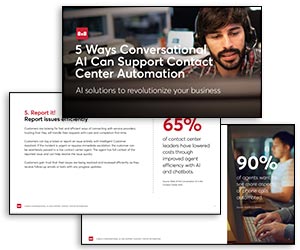Tricia Morris at 8×8 explains how contact centres are adapting to remote and hybrid work expectations.
For large organizations, “hybrid” means a messy buzz of many different work locations and schedules.
Some employees are in the office, some work remotely, while others straddle both locations working flexible or irregular shift patterns.
It’s frequently assumed that managing this model of working comes at the expense of service or support levels.
But does prioritizing the employee experience (EX) by enabling hybrid and remote work inevitably lead to a decline in the customer experience (CX)?
Not at all. The same cloud-based contact centre technologies that enable hybrid working also help to achieve operational excellence and significantly improve customer experience.
The link between EX and CX is strengthened by cloud-based contact centre platforms that are helping organizations adapt to the future of work—a future predicted by Arthur C. Clarke in 1964 when he noted that “men will no longer commute; they will communicate.”
Why Adapting Is Important: The Specter of Agent Attrition
Agent attrition remains one of the biggest issues within the contact centre. Attrition rates are significantly higher in the contact centre industry than in other sectors, ranging between an estimated 26% and 85%.
The expectations for remote and hybrid work options has only made this worse. Contact centres that are unable to meet the demand for new working patterns are coming to grips with the harsh reality that their agents can and will go elsewhere.
The statistics are now well known, but many employees would actively look for a new role if they couldn’t get remote or hybrid work schedules.
Three-fifths of workers would look for a new job if their current employer didn’t offer remote work options.
Faced with the ongoing and ever-present risk of agent attrition, contact centres must adopt cloud-based contact centre solutions to support both remote and hybrid forms of working so that they can attract and retain new and next-gen talent.
Failing to adapt is an expensive and time-consuming problem. The cost of recruiting and training new contact centre agents is significant, with many employees taking more than six months to become fully trained.
Not only does this impact a contact centre’s bottom line, but it also leads to a “brain drain” that can send first contact resolution and customer satisfaction levels plummeting.
From Adaptation to Operational Excellence
Cloud-based contact centre solutions, such as 8×8 contact centre, help contact centres to avoid the risks of agent attrition and adapt to a changing work landscape.
They have also given contact centre teams new tools and capabilities that help them find new efficiencies, drive operational excellence, and significantly enhance customer experience.
Two areas where many hybrid contact centres have capitalized on their new capabilities have been product integrations and automation.
Integrate and Customize With Ease
Cloud-based contact centres are incredibly powerful because they allow organizations to build bespoke environments tailored to their needs.
For example, while an on-premises contact centre may have only limited channels and capabilities, cloud-based contact centres focus on enabling native-feeling integrations.
If your organization wants to adapt to changes in its market, it can add a new social channel, for example, or integrate its CRM to give agents better insight into customers’ details and case histories.
Doing this prevents customers from having to repeat information or continually validate their identity, which greatly improves customer experience and satisfaction scores (CSAT).
When cloud-based contact centres are on the same platform as the organization’s unified communications solution, the benefits are even greater.
Metrigy research reports that customer ratings improve by 26.5%, operational costs drop by 18%, revenue increases by 22.6%, and employee productivity improves by 23.1%.
Accelerate Automation
By transitioning to a cloud-based contact centre solution, organizations also get to take advantage of innovative best-in-class AI technologies that enhance the customer experience in a variety of ways.
Many on-premises contact centres, because integrations are more complex or they don’t get regular innovation updates, lag when it comes to AI and automation.
Stay Ahead of the Competition
According to Metrigy research, 42% of organizations still use on-premises architecture and two-thirds of contact centre seats remain on-premises.
The need for cloud-based solutions brought on by hybrid working has accelerated many contact centres’ abilities.
This blog post has been re-published by kind permission of 8x8 – View the Original Article
For more information about 8x8 - visit the 8x8 Website
Call Centre Helper is not responsible for the content of these guest blog posts. The opinions expressed in this article are those of the author, and do not necessarily reflect those of Call Centre Helper.
Author: 8x8
Published On: 29th Jan 2024
Read more about - Guest Blogs, 8x8






 8x8 is transforming the future of business communications as a leading Software-as-a-Service provider of voice, video, chat, contact centre, and enterprise-class API solutions, powered by one global cloud communications platform.
8x8 is transforming the future of business communications as a leading Software-as-a-Service provider of voice, video, chat, contact centre, and enterprise-class API solutions, powered by one global cloud communications platform. 









